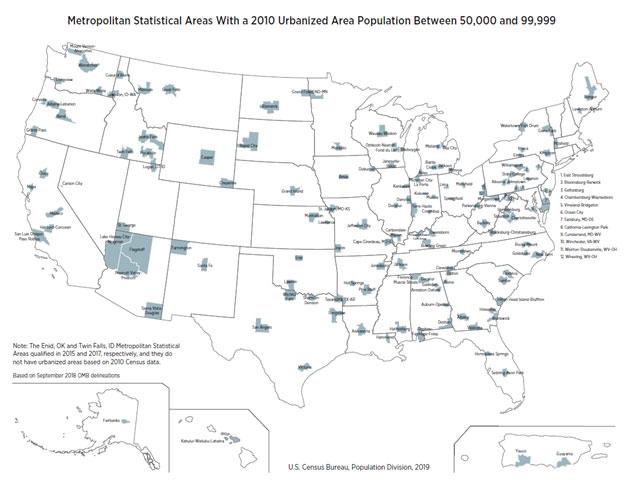Valorie Rice, Senior Business Information Specialist
(Read the comment EBRC Director George Hammond submitted to the U.S. Census Bureau on the proposed changes to the MSA designation.)
Under a recent OMB proposal, four Arizona MSAs could be redefined as micropolitan areas
Arizona currently has seven metropolitan areas: Flagstaff, Lake Havasu City-Kingman, Phoenix-Mesa-Chandler, Prescott Valley-Prescott, Sierra Vista-Douglas, Tucson, and Yuma. That number could dwindle down to just three (Phoenix, Tucson, and Yuma) based on a recent proposal from the Office of Management and Budget (OMB). The OMB is the federal entity that determines the criteria for the Metropolitan Statistical Area (MSA) designation.
Metropolitan statistical areas are composed of counties. The core county (or counties) of an MSA must contain an urbanized area with population of 50,000 or more. MSAs can include adjacent counties if there is enough integration between the counties (measured by commuting). For many parts of the country this is very common. In Arizona, the only example is the Phoenix-Mesa-Chandler MSA, which includes both Maricopa and Pinal counties.
The committee within the OMB reviewing metropolitan and micropolitan area standards brought forth six recommended changes. The first recommendation is garnering the most attention – it suggests that the minimum urban area population to qualify as an MSA should be increased from 50,000 to 100,000. This would affect about 144 metropolitan areas in the U.S. with an urbanized area currently below the proposed population threshold of 100,000, including four Arizona metropolitan areas.
What will happen to these areas if they lose the MSA designation? They will become micropolitan areas. Micropolitan statistical areas are similar in spirit to MSAs, but contain an urban cluster with a population of at least 10,000 but less than 50,000. With this proposal, micropolitan areas would include urban areas with populations that range from 10,000 to 99,999.
Arizona currently has four micropolitan areas: Santa Cruz County (Nogales), Gila County (Payson), Graham County (Safford), and Navajo County (Show Low). Flagstaff (Coconino County), Lake Havasu City-Kingman (Mohave County), Prescott Valley (Yavapai County) and Sierra Vista-Douglas (Cochise County) would join them if they were no longer designated as MSAs.
Why is this a big deal? Many data resources we use do not provide county level statistics – only state and metropolitan level statistics. This is the case for federal statistics such as Occupational Employment and Wage Estimates from the BLS, Regional Price Parities from BEA, and House Price Index from the FHFA, as well as nongovernment statistics such as the Housing Opportunity Index from NAHB. There are also some county-level data, such as GDP, that are complicated to aggregate to the MSA level if more than one county is involved. This is not an issue so much in Arizona, but would be for folks in other states.
Further, it is common for research and media organizations (like Brookings, the Milken Institute, Forbes, etc) to publish rankings and other analysis for MSAs but not for micropolitan areas. Thus, a region which is no longer designated as an MSA may receive less attention as a micropolitan area.
The MSA designation may also impact federal funding for the local areas, according to the General Accounting Office. Federal funds flowing to local areas tend to be more tied to the Census Urbanized Area designation, which also has proposed changes underway. For more see the Federal Register notice published on February 19, 2021. We will address this proposed change in an upcoming post.
Finally, losing the MSA designation may reduce the marketing profile of the region, particularly with respect to national or multi-state site selection searches.
For more analysis on these impacts, see “The Growth Impact of the Metropolitan Statistical Area Designation, by George Hammond and Brian Osoba in the Annuals of Regional Science, 2008, Volume 42, pages 307-319.
Figure 1 shows the metropolitan areas that would affected.
Figure 1: MSAs Likely to Be Impacted by the Proposed Changes

For a interactive and more detailed map showing which metropolitan areas would remain and which would be lost can be found at The Daily Yonder.





